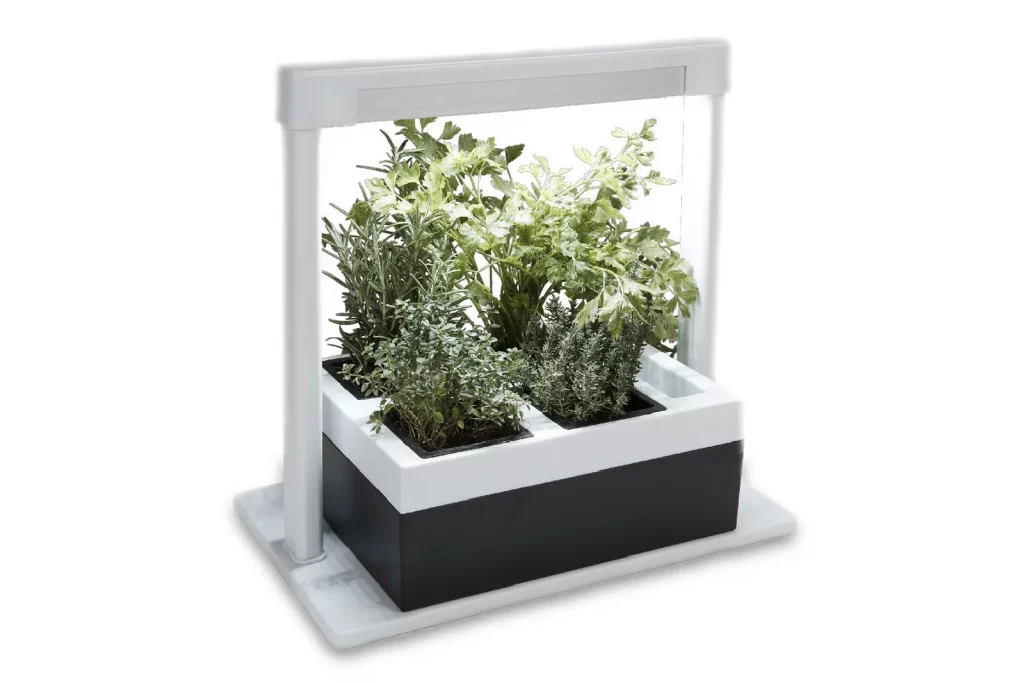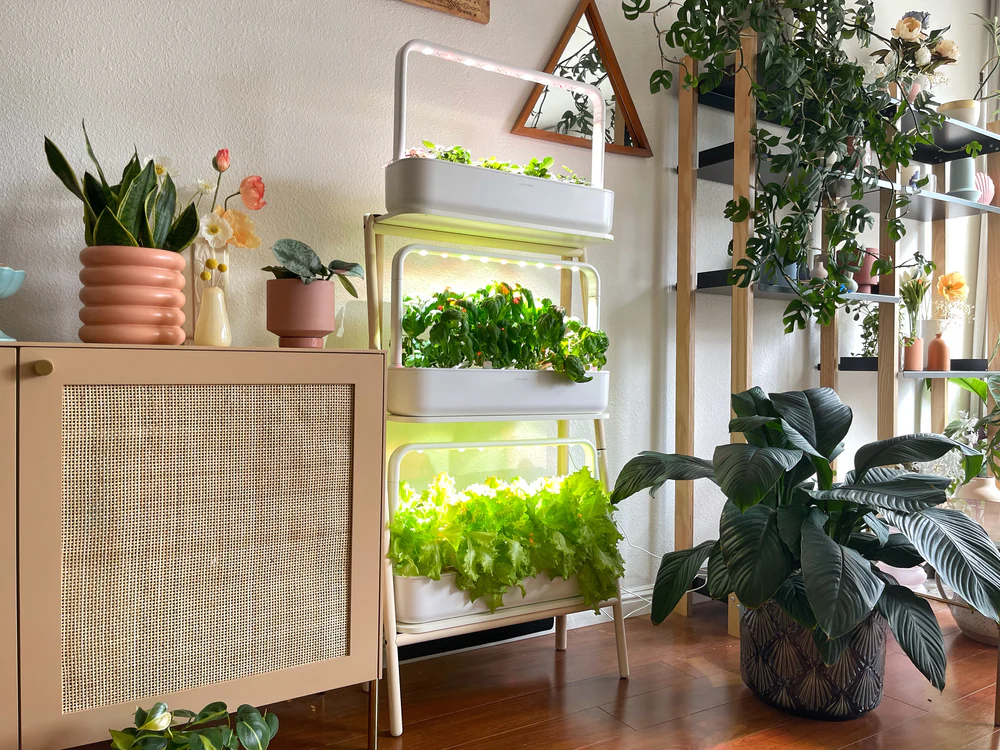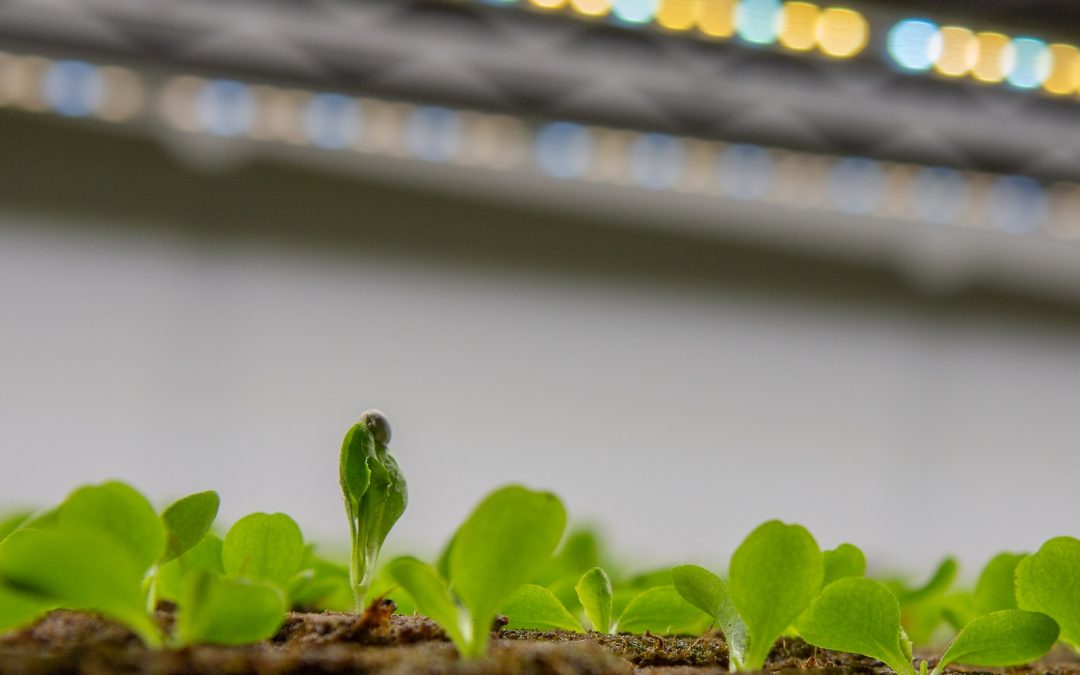If your plants always look a bit leggy or dull, it’s usually not the soil – it’s the light. Choosing the best lights for indoor gardening can be the difference between weak, stretched stems and compact, lush growth.
Natural windowsill light is great, but it’s rarely perfect all year round. A good grow light fills that gap so your herbs, leafy greens, fruiting plants and houseplants all get the hours of light they actually need.
If you’d like a full care routine that covers watering, feeding and humidity as well as light, you can also read the Indoor Garden Care as a next step.
Contents
- 0.1 Why Indoor Plants Need Artificial Light
- 0.2 Best Grow Lights for Indoor Gardening: Types Compared
- 0.3 How to Choose the Best Grow Light for Your Space
- 0.4 Light Colour, Spectrum and Brightness – Without the Jargon
- 0.5 How Long to Run Grow Lights Each Day
- 0.6 Practical Setup Ideas for Different Homes
- 0.7 Common Mistakes With Grow Lights
- 0.8 FAQs About the Best Lights for Indoor Gardening
- 0.9 Final Thoughts on the Best Lights for Indoor Gardening
- 0.10 Related Articles
- 1 Explore Essential Indoor Gardening Tools & Tips
Why Indoor Plants Need Artificial Light
Quick answer: which grow light should you buy?
For most houseplants: full-spectrum LED grow light
For shelves/herbs: LED grow light bar
For one plant by a sofa: clip-on grow light
Run it 10–14 hours for growth (less in summer, more in winter)
Keep lights close above the leaves, not across the room
Here’s why indoor plants often struggle without extra light.
Most indoor spaces simply don’t give plants:
Enough hours of light (especially in winter).
The right light intensity.
The correct light spectrum (colour mix).
Grow lights solve this by:
For more detail on positioning, see Grow Light Placement.
Extending “day length” to 10–16 hours.
Providing stronger, more consistent light.
Supplying the red and blue wavelengths plants use most for growth and flowering.

Best Grow Lights for Indoor Gardening: Types Compared
1. LED Grow Lights (Best All-Round Choice)
LEDs are usually the best lights for indoor gardening for most people:
Energy efficient – low running costs and minimal heat.
Long lifespan – often 25,000–50,000 hours.
Cool running – safer near leaves and ideal for small spaces.
Available as panels, bars, strips, clamp lamps and bulbs.
Look for:
Full-spectrum or “white” grow LEDs for a natural look in living spaces.
Stated PPFD or PAR values if the manufacturer provides them – higher numbers mean stronger light at a given distance.
You could hang a full-spectrum LED grow light panel above a shelf of seedlings or salad leaves and keep it on a timer through winter evenings.
2. Fluorescent Tube and CFL Grow Lights
Fluorescent lights are still useful if you’re on a tighter budget:
Good for seedlings, leafy greens and herbs.
Spread light over a wider area – helpful for propagation trays.
Run fairly cool, so they can be placed closer to plants.
Best choices:
T5 fluorescent grow light fixtures – slim tubes with good output.
CFL grow bulbs – useful if you want a single lamp over a small area.
3. HID Lights (HPS / Metal Halide)
High-intensity discharge (HID) lights are powerful but less common for home growers now:
Very bright – suitable for large, dedicated grow rooms.
Run hot and use more electricity.
Usually overkill for small apartments or a few herbs on a counter.
For most indoor home gardens, LEDs give a better balance of heat, efficiency and ease of use.
How to Choose the Best Grow Light for Your Space
When you’re deciding on the best lights for indoor gardening, think about:
1. What You’re Growing
Leafy herbs and salad (basil, mint, lettuce):
Medium-strength LED bar or panel, 10–14 hours per day.Fruit or veg (peppers, tomatoes, dwarf citrus):
Stronger LED panel with high output, 12–16 hours per day.Houseplants (monsteras, pothos, snake plants):
Moderate full-spectrum LED bulb or bar to top up low window light.
2. The Size of the Area
Measure the space you want to light:
Single pot or two: a clamp-on LED grow lamp or E27 grow bulb in a desk lamp can be enough.
Shelf or windowsill: a 60–90 cm LED grow bar mounted above the plants works well.
Whole rack or table: consider a rectangular LED panel that covers the whole footprint.
A rough rule: the grow light should be large enough to cover most of the plant canopy when you look straight down from above.
3. Distance From Plants
Light intensity drops quickly with distance, so:
Start with LEDs around 20–30 cm above herbs and seedlings.
For houseplants that are sensitive to strong light, you might hang the light 40–50 cm above the leaves.
Watch the foliage: pale, crispy tips mean too much light; stretching towards the fixture means not enough.
Light Colour, Spectrum and Brightness – Without the Jargon
You’ll often see grow lights sold as:
“Full spectrum” or “daylight” – a mix of cool and warm white, great for general use.
Red/blue “blurple” LEDs – very efficient, but the purple glow is harsher in living rooms.
Colour temperature (Kelvin) – 4000–6500K is typical for plant growth.
For most home setups, a full-spectrum white LED grow light is ideal. It looks like normal light but still supports strong photosynthesis.
If you want to dive deeper into spectrum graphs and PAR charts, a trusted horticultural site such as the RHS grow light advice pages is a good place to check technical details.
How Long to Run Grow Lights Each Day
General guidelines for indoor plants:
Low-light houseplants: 8–10 hours added artificial light may be enough.
Herbs and leafy greens: 10–14 hours total light (natural + artificial).
Fruit/veg and dwarf fruit trees: 12–16 hours in their active growth phase.
Tips:
Use a plug-in timer so lights turn on and off automatically.
Try to keep a regular “day/night” rhythm – plants need dark time too for proper metabolism.
If leaves start to look washed out, reduce the hours slightly or raise the light.
Pair your grow light with a simple plug-in timer switch so you don’t have to remember daily on/off times.
Practical Setup Ideas for Different Homes
Small Flat or Bedroom
LED clamp lamp on a desk, aimed at a cluster of plants.
Narrow LED grow strip underneath a shelf for succulents or herbs.
Keep cables neat with clips and cable ties.
Kitchen Herb Station
Mount a slim LED bar under a wall cabinet above your herb pots.
Set the timer to run extra hours in the evening while you cook.
Combine with your miniature kitchen herb garden article as a companion guide.
Dedicated Indoor Garden Corner
Use a metal shelving rack with one LED panel per shelf.
Group plants by light needs – sunlovers on the top shelf, shade-lovers lower down.
Add a reflective backdrop (white wall or mylar sheet) to bounce light back onto plants.

Common Mistakes With Grow Lights
Avoid these easy pitfalls:
Lights too far away – plants stretch and lean towards the fixture.
Too few hours – growth slows and leaves stay small.
Overheating with old HID lamps – scorched leaves and dry soil.
Ignoring watering changes – brighter light means plants may drink more, so check soil more often.
No plan for summer – in bright months you may only need the lights on cloudy days or evenings.
FAQs About the Best Lights for Indoor Gardening
1. Can I use normal LED bulbs as grow lights?
Yes, for low-light houseplants you can get away with bright, cool-white LED bulbs, especially if they’re fairly close. However, dedicated grow bulbs give a better spectrum and stronger output, making them a better choice for herbs and food crops.
2. How do I know if my plants need more light?
Look for long, thin stems, large gaps between leaves, pale colours and leaves leaning strongly towards the window or lamp. If that’s happening, either lower the light, move it closer, or extend the lighting hours.
3. Will grow lights increase my electricity bill a lot?
Modern LED grow lights are quite efficient. A 40W–60W panel running 12 hours per day typically costs much less than older fluorescent or HID lamps – often similar to running an extra bright room lamp.
4. Are grow lights safe to have in a bedroom or living room?
Most LED grow lights are safe if used according to the instructions: don’t stare directly into them for long periods, keep them away from flammable materials, and make sure fixtures are secure. Full-spectrum white LEDs look more natural and are less harsh on the eyes than purple lights.
5. How soon will I see a difference after adding a grow light?
You’ll often notice sturdier new growth within a few weeks – tighter spacing between leaves, stronger colour and increased flowering or fruit set in suitable plants.
Final Thoughts on the Best Lights for Indoor Gardening
Getting the best lights for indoor gardening isn’t about buying the biggest, brightest fixture you can find – it’s about matching light strength and coverage to your plants and your space.
Start by:
Deciding what you want to grow.
Choosing an LED bar, panel or bulb that fits the area.
Setting a simple timer schedule and adjusting height based on how your plants respond.
Once the light side of the equation is sorted, you’ll find watering, feeding and general care much easier, because your plants are finally getting the energy they need to thrive
Related Articles
UPGRADE THE REST OF YOUR INDOOR GARDEN SETUP
Explore Essential Indoor Gardening Tools & Tips
Now that your lighting is sorted, the next step is having the right tools to keep everything thriving. From moisture meters and pruning snips to the best pots and watering cans, this guide walks you through the gear that actually makes indoor gardening easier, not more complicated.

